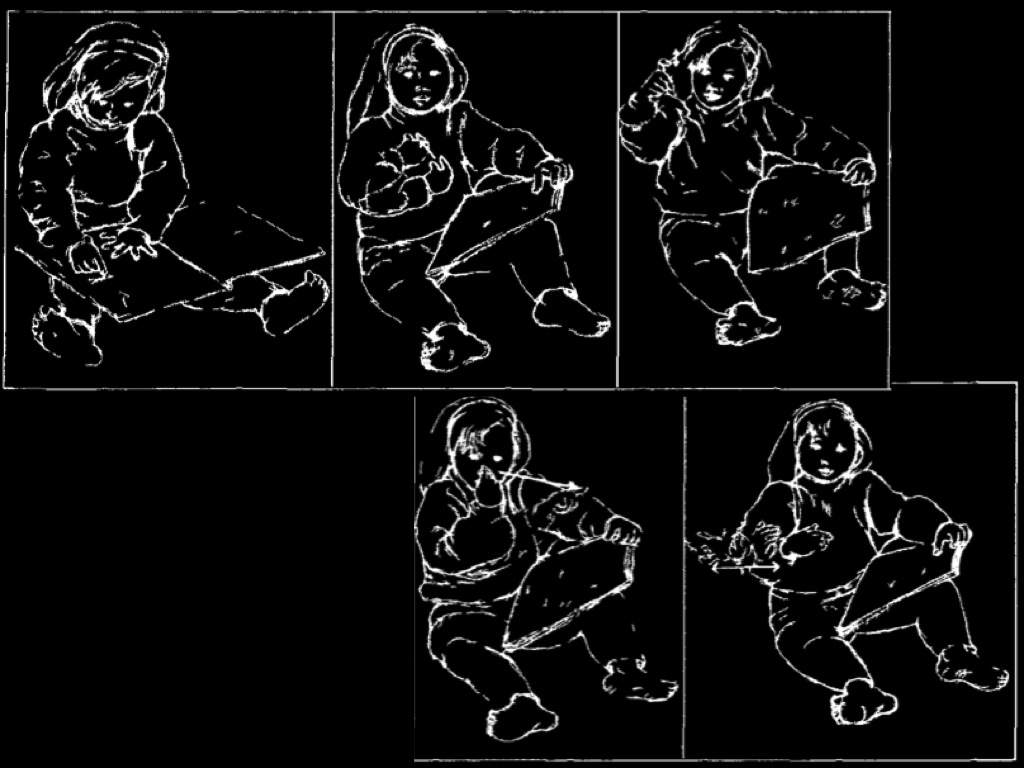Click here and press the right key for the next slide.
(This may not work on mobile or ipad. You can try using chrome or firefox, but even that may fail. Sorry.)
also ...
Press the left key to go backwards (or swipe right)
Press n to toggle whether notes are shown (or add '?notes' to the url before the #)
Press m or double tap to slide thumbnails (menu)
Press ? at any time to show the keyboard shortcuts

Creating Language
How do children acquire their first words?
‘A child learning to speak is learning habits and associations which are just as much determined by the environment as the habit of expecting dogs to bark and cocks to crow’
(Russell 1921, p. 71)
‘[t]he child learns this language from the grown-ups by being trained to its use. I am using the word ‘trained’ in a way strictly analogous to that in which we talk of an animal being trained to do certain things. It is done by means of example, reward, punishment, and suchlike’
(Wittgenstein 1972, p. 77).
‘the child’s early learning of a verbal response depends on society's reinforcement of the response in association with the stimulations that merit the response’
(Quine 1960, p. 82)
habitual process
Action occurs in the presence of Stimulus.
Agent is rewarded [/punished]
Stimulus-Action Link is strengthened [/weakened] due to reward [/punishment]
Given Stimulus, will Action occur? It depends on the strength of the Stimulus-Action Link.
no understanding required
‘Crying is the first step toward language when crying is found to procure one or another form of relief or satisfaction. More specific sounds, imitated or not, are rapidly associated with more specific pleasures’
‘there is a rudiment of communication in the simple discovery that sounds produce results. Crying is the first step toward language when crying is found to procure one or another form of relief or satisfaction. More specific sounds, imitated or not, are rapidly associated with more specific pleasures.
‘A large further step has been taken when the child notices that others also make distinctive sounds at the same time the child is having the experiences that provoke its own volunteered sounds. For the adult, these sounds have a meaning, perhaps as one word sentences. The adult sees herself as doing a little ostensive teaching: “Eat,” “Red,” “Ball,” “Mamma,” “Milk,” “No.” There is now room for what the adult views as error: the child says “Block” when it is a slab. This move fails to be rewarded, and the conditioning becomes more complex’
(Davidson 2000: 70-1; see also Davidson 1999: 11).
Assumption:
If someone can think, she can communicate with words.
Consequence:
Acquiring words cannot involve thinking at the outset.
Question:
How could someone begin to acquire create words without being able to think?
Answer:
By being trained to utter a particular word in response to certain simulations!
But:
How do children actually acquire their first words?
children create and creatively adapt words before (and after) learning those of the adults around them
INVESTIGATOR: what is that called?
SHEM: dat's uh vam.
INVESTIGATOR: a vam?
SHEM: yeah.
INVESTIGATOR: why is it called a vam?
SHE: it vams all duh room ups all the water up ...
source: Eve Clark's CHILDES data
(Clark 1982; MacWhinney 2000)
homesigns

Goldin-Meadow (2003, figure 1)
Children can create their own languages
with no experience of others' languages

Goldin-Meadow (2003, figure 2)

Goldin-Meadow (2003, figure 11)

Goldin-Meadow (2003, figure 22)
Gesture forms are:
- stable
- arbitrary
- systematic
Gesture forms are used:
- with different forces (to ask questions, make comments, request things, ...)
- to talk about past, future and hypothetical things
- to tell stories
- to communicate with oneself
- to talk about gestures (metalanguage)
Goldin-Meadow 2002
Assumption:
If someone can think, she can communicate with words.
Consequence:
Acquiring words cannot involve thinking at the outset.
Question:
How could someone begin to acquire create words without being able to think?
Answer:
By being trained to utter a particular word in response to certain simulations!
But:
How do children actually acquire their first words?
‘children learn words through the exercise of reason’ (Bloom, 2001, p. \ 1103; see Bloom, 2000)
Bloom 2001, p. 1103
‘much of what goes on in word learning is establishing a correspondence between the symbols of a natural language and concepts that exist prior to, and independently of, the acquisition of that language’
Bloom 2000, p. 242
‘Augustine describes the learning of human language as if the child came into a strange country and did not understand the language of the country; that is, as if it already had a language, only not this one. Or again: as if the child could already think, only not yet speak.’
(Wittgenstein 1953, p. 15--16, §32)
lab rat or shipwreck survivor?